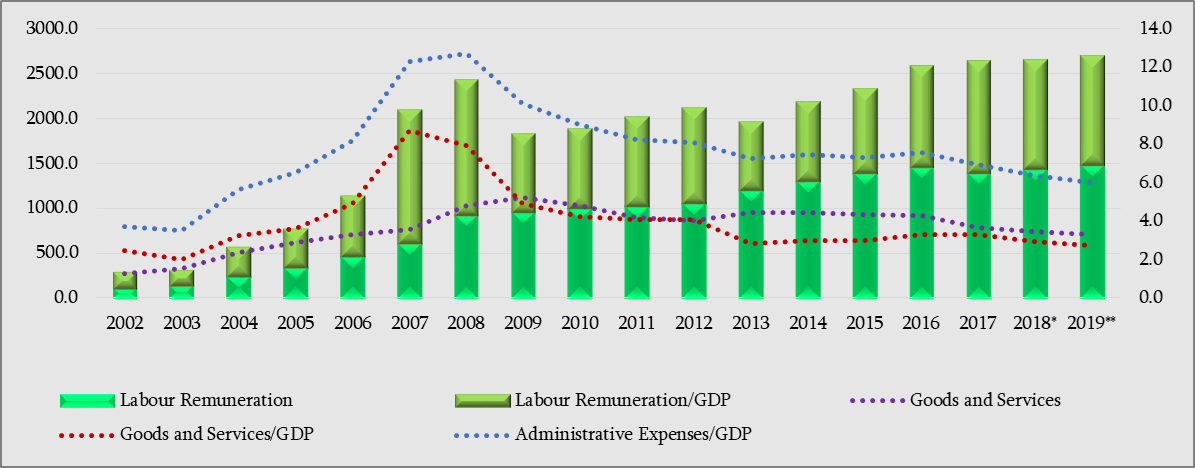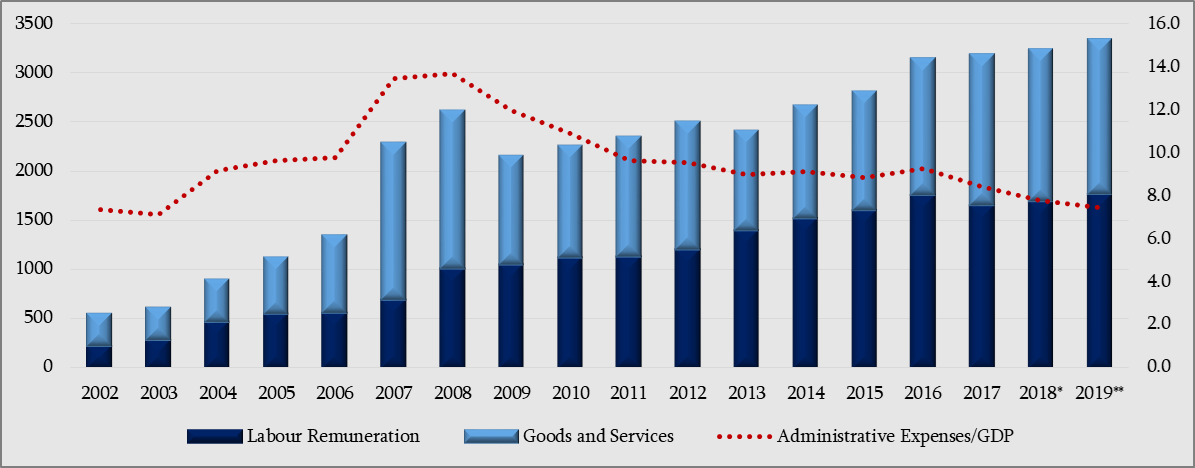Resume: It is true that in 2019, the nominal figure of the state budget’s administrative expenses are indeed GEL 578.4 million more as compared to 2012. However, it would be an exaggeration to put all of these expenses into the bureaucratic category because it also includes expenses that are not intended for bureaucratic processes (for instance, funding for the police, military, etc.).
Of note is that an analysis of the changes of nominal figures over time is not relevant and it is necessary to analyse the relative figures in order to see the real picture. In this period, the relative figures of the budget’s administrative expenses have a tendency of decline and it is estimated that the administrative expenses to GDP ratio will be 6.0% in 2019 whereas this figure was 8.1% in 2012. The share of administrative expenses in budget appropriations also decreases. In 2012, the share of administrative expenses in budget appropriations was 28.9% whilst this figure for 2019 is planned to be 6.1 percentage points less and equal to 22.8%. In other words, for every GEL 100 spent, the Government of Georgia spent GEL 28.9 to fund itself in 2012 whilst this figure will decrease to GEL 22.8 in 2019.
As compared to 2012, the nominal figures of state budget’s expenditures have increased by 61.7%. This includes a 46.8% growth in current expenses and a 195.5% growth in the nominal figure of the budget’s capital expenses. In the same period, the nominal figures of the budget’s administrative expenses increased by 40.1%. This means that the budget’s total appropriations, including the nominal figures of capital expenses, have increased much more as compared to administrative expenses.
Of note is that questions could be raised (even if the share of administrative expenses has decreased) in regard to the efficiency and the expediency of administrative expenses and whether or not they could be reduced even more.
Therefore, whilst Irakli Abesadze’s figure is accurate, it does not give a relevant picture for comparison over time because it is a nominal figure and not a real one. Therefore, taking into account the full context, FactCheck concludes that the MP’s statement is MOSTLY FALSE.
Analysis
European Georgia Movement for Freedom MP, Irakli Abesadze, spoke about bureaucratic expenses during the committee hearing on the draft state budget. As stated by the MP: “In 2019, we will spend GEL 580 million more on bureaucracy as compared to 2012.”
The administrative expenses of the state budget include the total sum of labour remuneration and goods and services. Of note is that the expenses provided for defence capability and public order (police) are also categorised under the goods and services component. Therefore, they should not be considered as administrative expenses. These components also partially include expenses for other structural units such as the Emergency Service (fire service, ambulance), schools and courts and it is difficult to straightforwardly categorise them as administrative (bureaucratic) expenses. However, it is impossible to fully separate these expenses from the total administrative expenses. Therefore, these expenses are also part of the calculation which results in an exaggeration of administrative expenses. Hence, it is incorrect to consider administrative expenses as entirely bureaucratic expenses.
In order to compare the budget’s administrative expenses over the years, it is necessary to compare relative figures instead of analysing nominal indicators. This is because the state budget’s nominal figures increase over the years and, therefore, the nominal figures of administrative expenses increase as well. Another reason behind the increased nominal figures of administrative expenses is inflation. In particular, as a result of annual price hikes, a smaller amount of money was needed to purchase the same amount of goods and services in 2012 as compared to the present day. The labour remuneration of public sector employees cannot be kept at the same level and in light of economic growth, it is objectively necessary to increase it too which also bloats the nominal figures of administrative expenses. Therefore, analysing relative figures is necessary to have an impartial analysis of the trend of changes in administrative expenses.
In 2012, the nominal figure of the state budget’s administrative expenses (labour remuneration and goods and services) amounted to GEL 2,110.4 million which was 8.1% of the country’s GDP. In the same year, the budget allocated funds for labour remuneration was 4.0% of the GDP whilst the funds allocated for goods and services amounted to 4.1% of the GDP. In 2013-2015, the relative figure of labour remuneration increased by 0.4 of a percentage point whilst the relative figure of goods and services decreased by 1.1 percentage points. In total, this resulted in a decreasing of the relative figures of administrative expenses. In 2016, administrative expenses did increase but they have been decreasing since 2016. In accordance with the estimates of the 2019 state budget, the nominal figure of total administrative expenses is GEL 2.688.8 million which constitutes 6.0% of the estimated GDP of 2019. The labour remuneration to GDP ratio is 3.3% whilst the goods and services component to GDP ratio is 2.7%.
Graph 1: Administrative Expenses of the State Budget (GEL Million, %)

Source: Ministry of Finance of Georgia
In the 2019 state budget, the planned amount of administrative expenses is GEL 578.4 million more as compared to 2012. However, the administrative expenses to GDP ratio decreased from 8.1% to 6.0%. In the same period, the nominal figures of state budget appropriations (current expenses and capital expenses) increased by 61.7% (GEL 4,498.6 million). This includes a growth of current expenses by 46.8% (GEL 3,078.4 million) and a growth of capital expenses by 195.5% (GEL 1,423.8 million) whilst the nominal figures of administrative expenses increased by 40.1% (GEL 587.4 million). In addition, the share of the state budget’s administrative expenses in the current expenses has been decreasing. In 2012, the administrative expenses to current expenses ratio was 32.1% whilst this figure is estimated to be 27.9% in 2019 which is 4.3 percentage points lower. There is the same trend in regard to budget appropriations (current expenses and capital expenses). In 2012, the share of administrative expenses to budget appropriations was 28.9% whilst the planned amount for 2019 is 6.1 percentage points lower and amounts to 22.8%. Therefore, administrative expenses decline in the state budget’s current expenses in 2012-2019 whilst the budget’s capital expenses increase in the same period.
Graph 2:Administrative Expenses of the Consolidated Budget (GEL Million, %)

Source: Ministry of Finance of Georgia
The trend of changes in the administrative expenses of the consolidated budget is similar to that of the trend in the state budget. In 2012, the consolidated budget’s administrative expenses to GDP ratio was 9.6% whilst there are plans to cut the ratio to 7.4% in 2019. For more details, see here.








